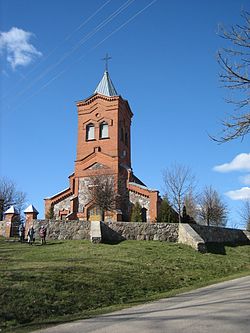
Vilnius is the capital and the largest city of Lithuania, with a population of 593,436 as of 2023. The Vilnius urban area, extending beyond the city limits, had an estimated population of 718,507 in 2020. By November 2022, there were approximately 753,875 permanent residents in Vilnius city and Vilnius district municipalities combined.

Vištytis is a small town in Marijampolė County, in southwestern Lithuania. It is the administrative centre of Vištytis elderate within Vilkaviškis District Municipality.

Panevėžys is the fifth largest city in Lithuania. As of 2021, it occupies 50 square kilometres (19 sq mi) with 89,000 inhabitants. As defined by Eurostat, the population of the Panevėžys functional urban area, that stretches beyond the city limits, is estimated at 127,471.

Plungė is a city in Lithuania with 17,252 inhabitants. Plungė is known for Plungė Manor and its park, where the Samogitian Art Museum is located. In the Oginskiai manor park stands the Perkūnas oak natural monument. The Lourdes of Plungė was created in 1905 and attracts visitors to this day. In the center of Plungė stands a monument for the 10th anniversary of regaining the independence of Lithuania and a sculpture of Saint Florian built by the Lithuanian book carrier Kazys Barzdys.

Kretinga is a City in Klaipėda County, Lithuania. It is the capital of the Kretinga district municipality. It is located 12 km (7.5 mi) east of the popular Baltic Sea resort town of Palanga, and about 25 km (16 mi) north of Lithuania's 3rd largest city and principal seaport, Klaipėda.

Palanga is a resort city in western Lithuania, on the shore of the Baltic Sea.
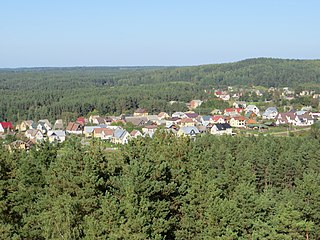
Ignalina is a town in eastern Lithuania. It is known as a tourist destination in the Aukštaitija National Park. Ignalina is also famous for the Ignalina Nuclear Power Plant in nearby Visaginas.

Rietavas is a town in Lithuania on the Jūra River. According to the 2001 census it had a population of 3,979. It is the capital of Rietavas municipality.

Kuršėnai is the twenty-fifth largest town in Lithuania. According to the 2023 estimate, it had 10,651 residents.
The Glinciszki massacre was a mass murder of Polish civilians by the German-subordinated 258th Lithuanian Police Battalion, committed on 20 June 1944 in the village of Glinciszki during World War II. In the massacre 39 civilians were murdered including 11 women, 11 children, and 6 elderly men. They were executed as a collective punishment for the death of four Lithuanian auxiliary policemen the previous evening.

Vilkaviškis is a city in southwestern Lithuania, the administrative center of the Vilkaviškis District Municipality. It is located 25 km (16 mi) northwest from Marijampolė, at the confluence of Šeimena and Vilkauja rivers.

Simnas is small town on the river Dovinė between Simnas and Giluitis lakes, in Alytus district, Alytus county, in the south of Lithuania. It lies on the 131 a national primary road from Alytus to Kalvarija. Simnas located within the ethnographical region Dzūkija. According to the 2022 data, 1209 people live in the town with 3148 in Simnas eldership. It is most populous settlement in Alytus district.
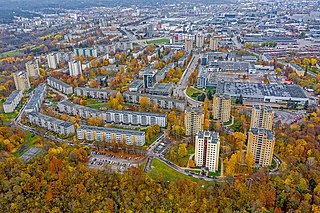
Žirmūnai is the most populous administrative division (elderate) in Vilnius. It is also a neighbourhood in the Lithuanian capital city Vilnius, encompassing the city district of the same name, built in the 1960s.

Bezdonys is a town in Lithuania, located to the north of Vilnius, within the Vilnius district municipality. It is best known for the 1908 Bezdany raid, one of the most daring and successful train robberies in history. According to the Lithuanian census of 2011, the town had 743 inhabitants.
The Koniuchy massacre or the Kaniūkai massacre was a World War II massacre of civilians, mostly women and children, carried out in the village of Koniuchy on 29 January 1944 by a Soviet partisan unit together with a contingent of Jewish partisans under Soviet command. At least 38 civilians who have been identified by name were killed, and more than a dozen were injured. In addition, houses were burned and livestock was slaughtered. It was the largest atrocity committed by the Soviet partisans in present-day Lithuania.
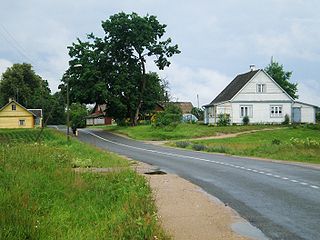
Labanoras [ɫaba'noːras], Polish: Łabonary, is a small town within the Labanoras Regional Park in Lithuania. It is situated on Labanoras Lake and is surrounded by the Labanoras Regional Park, the largest regional park in Lithuania. As a center of the Labanoras Park, the town attracts tourists. A hotel and restaurant were opened in a former school building in 2003. According to the Lithuanian census of 2011, the town had 59 residents.

Lentvaris Manor is a former residential manor in Lentvaris, Trakai District Municipality, Lithuania.
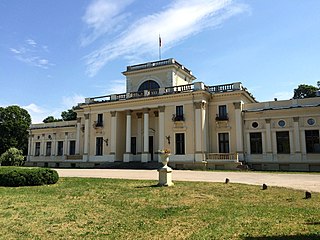
Traku Voke Manor is a former residential manor in Traku Voke. It is a monument of historicist architecture with elements of Neo-Gothic, classicism, eclectic style, located halfway between Vilnius and Trakai. The Manor was established in the end of the 19th century.

Bitėnai is a small village in the Pagėgiai Municipality, in western Lithuania. According to the 2011 census, it had population of 76, a decline from 119 in 2001. It is situated along the Neman River near the Rambynas hill and is known as the location of the Martynas Jankus printing press. Jankus Museum and the visitors' center of the Rambynas Regional Park are located in the village.
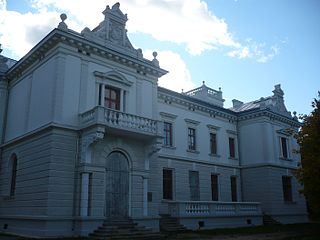
Vilkėnas Manor is a former residential manor in Vilkėnas Village, Švėkšna, Lithuania.
